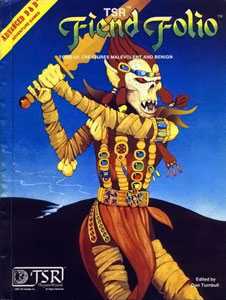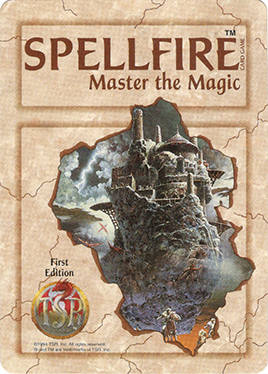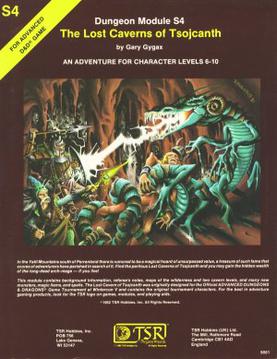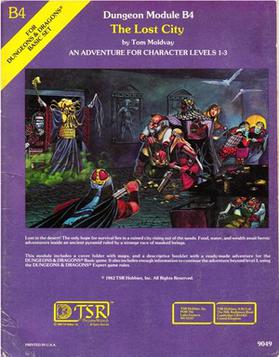 | |
| Genre | Role-playing game |
|---|---|
| Publisher | TSR |
Publication date | 1981 |
Monster Cards is an accessory for the Dungeons & Dragons fantasy role-playing game.
 | |
| Genre | Role-playing game |
|---|---|
| Publisher | TSR |
Publication date | 1981 |
Monster Cards is an accessory for the Dungeons & Dragons fantasy role-playing game.
The Monster Cards were sets of twenty 3" by 5" cards intended as a Dungeon Master's aid, with each card having a color illustration of a monster on one side and game statistics for the monster on the other side. [1]
The Monster Cards Sets 1 through 4 were designed by the TSR Design Staff, with art by Jeff Dee, Erol Otus, Jim Roslof, Darlene Pekul, and Bill Willingham, and were published by TSR in 1981 as sets of 20 color cards in a small clear plastic box. [1] Additional contributing artists included Jim Holloway, Harry Quinn, Steve Sullivan, and Dave LaForce. [2]
A second group of four sets was tentatively scheduled for release in 1983, according to Harold Johnson, and those sets would have included several monsters from the Fiend Folio book. [2]
| | This section is empty. You can help by adding to it. (June 2011) |

Dungeons & Dragons is a fantasy tabletop role-playing game (RPG) originally designed by Gary Gygax and Dave Arneson. The game was first published in 1974 by Tactical Studies Rules, Inc. (TSR). It has been published by Wizards of the Coast since 1997. The game was derived from miniature wargames, with a variation of the 1971 game Chainmail serving as the initial rule system. D&D's publication is commonly recognized as the beginning of modern role-playing games and the role-playing game industry, and also deeply influenced video games, especially the role-playing video game genre.

Fiend Folio is the name of three separate products published for successive editions of the fantasy role-playing game Dungeons & Dragons (D&D). All three are collections of monsters.

Expedition to the Barrier Peaks is a 1980 adventure module for the Dungeons & Dragons role-playing game written by Gary Gygax. While Dungeons & Dragons (D&D) is typically a fantasy game, the adventure includes elements of science fiction, and thus belongs to the science fantasy genre. It takes place on a downed spaceship; the ship's crew has died of an unspecified disease, but functioning robots and strange creatures still inhabit the ship. The player characters fight monsters and robots, and gather the futuristic weapons and colored access cards that are necessary for advancing the story.

Spellfire: Master the Magic is an out-of-print collectible card game (CCG) created by TSR, Inc. and based on their popular Dungeons & Dragons role playing game. The game appeared first in April 1994, shortly after the introduction of Magic: The Gathering, in the wake of the success enjoyed by trading card games. It was the second CCG to be released, preceding Wizards of the Coast's second CCG Jyhad by two months.

Dragon Strike is a 1993 adventure board game from TSR, Inc. based on the Dungeons & Dragons (D&D) fantasy role-playing game. It was intended to be a pathway for beginners to start with, and for players to eventually play the full Advanced Dungeons & Dragons tabletop game after kindling their interest.

Ravenloft is an adventure module for the Dungeons & Dragons (D&D) fantasy role-playing game. The American game publishing company TSR, Inc. released it as a standalone adventure booklet in 1983 for use with the first edition Advanced Dungeons & Dragons game. It was written by Tracy and Laura Hickman, and includes art by Clyde Caldwell with maps by David Sutherland III. The plot of Ravenloft focuses on the villain Strahd von Zarovich, a vampire who pines for his lost love. Various story elements, including Strahd's motivation and the locations of magical weapons, are randomly determined by drawing cards. The player characters attempt to defeat Strahd and, if successful, the adventure ends.
An owlbear is a fictional creature originally created for the Dungeons & Dragons fantasy role-playing game. An owlbear is depicted as a cross between a bear and an owl, which "hugs" like a bear and attacks with its beak. Inspired by a plastic toy made in Hong Kong, Gary Gygax created the owlbear and introduced the creature to the game in the 1975 Greyhawk supplement; the creature has since appeared in every subsequent edition of the game. Owlbears, or similar beasts, also appear in several other fantasy role-playing games, video games and other media.

Palace of the Silver Princess is an adventure module for the Dungeons & DragonsBasic Set. It was recalled on the same day it was released, then rewritten and re-released some months later. The original version, with an orange cover, was written in 1980 by Jean Wells. When the orange version was recalled, the module was rewritten by Tom Moldvay and released with a green cover. Writing credit on the second version was given to both Moldvay and Wells, although there was very little of Wells' original content in Moldvay's version.

Battlesystem is a tabletop miniature wargame designed as a supplement for use with the Dungeons & Dragons role-playing game. The original Battlesystem was printed as a boxed set in 1985 for use with the first edition AD&D rules. For the second edition of AD&D, a new version of Battesystem was printed as a softcover book in 1989.

The Forgotten Temple of Tharizdun is an adventure module for the Dungeons & Dragons (D&D) role-playing game, for use in the World of Greyhawk campaign setting. The module was published by TSR, Inc. in 1982 for the first edition Advanced Dungeons & Dragons rules.

In the Dungeons & Dragons fantasy role-playing game, goblins are a common and fairly weak race of evil humanoid monsters. Goblins are non-human monsters that low-level player characters often face in combat.
James Paul Roslof was an American artist who produced cover art and interior illustrations of fantasy role-playing games published by TSR, Inc. during the "golden age" of Dungeons & Dragons. As Art Director at TSR in the early 1980s, he was also responsible for hiring many of the young artists who would go on to careers in the fantasy role-playing industry.

Dungeon! is an adventure board game designed by David R. Megarry and first released by TSR, Inc. in 1975. Additional contributions through multiple editions were made by Gary Gygax, Steve Winter, Jeff Grubb, Chris Dupuis and Michael Gray. Dungeon! simulates some aspects of the Dungeons & Dragons (D&D) role-playing game, which was released in 1974, although Megarry had a prototype of Dungeon! ready as early as 1972.

The Lost Caverns of Tsojcanth is an adventure module for the Dungeons & Dragons fantasy role-playing game. It was written by Gary Gygax and published by TSR in 1982 for the first edition Advanced Dungeons & Dragons (AD&D) rules. The 64-page adventure bears the code "S4" and is set in the Greyhawk campaign setting. It is divided into two parts, a 32-page adventure, and a 32-page booklet of monsters and magic items. The plot involves the player characters investigating rumors of lost treasure. After traversing a wilderness and two levels of dungeons, the players face Drelnza, the vampiric daughter of long-deceased archmage Iggwilv.
The DL series is a series of adventures and some supplementary material for the Advanced Dungeons & Dragons role playing game. These modules along with the Dragonlance Chronicles trilogy of novels, which follow one possible adventure series through the modules, were the first published items that established the Dragonlance fictional universe. The original DL series was released from 1984 to 1986, with the final two modules added to it in 1988. In the 1990s these roleplaying adventures from the original series were collected and revised for 2nd Edition AD&D as the three DLC Dragonlance Classics modules. There were also versions of the module series released in 1999, 2000 and 2006.

Horror on the Hill is an adventure module published by TSR, Inc. in 1983, for the Basic Rules of the Dungeons & Dragons fantasy role-playing game. Its product designation was TSR 9078. This 32-page book was designed by Douglas Niles, and features cover artwork by Jim Roslof. It is intended for beginning gamemasters and 5–10 player characters of levels 1–3. The module contains around 20 encounters on the surface, a monastery, three dungeon levels and three new monsters.

The Lost City (B4) is a Dungeons & Dragons adventure module by Tom Moldvay. It was first published by TSR in 1982 and was designed as a stand-alone adventure for use with the Dungeons & Dragons Basic Set. The working title for the module was "The Lost City of Cynidicea". Moldvay designed the module as a low-level scenario to give novice Dungeon Masters experience in fleshing out adventures such that it is only partially complete. The plot involves the player characters discovering a ruined subterranean city slowly rising out of the sands. The adventure is set inside a huge step pyramid, with the lower pyramid only sketched out and the city itself described with a list of the major areas and a map. The adventure's main villain is Zargon, a giant one-eyed monster and his minions. The entire double pyramid, not including the city, contains over 100 rooms.

The Dungeons & Dragons Basic Set is a set of rulebooks for the Dungeons & Dragons (D&D) fantasy role-playing game. First published in 1977, it saw a handful of revisions and reprintings. The first edition was written by J. Eric Holmes based on Gary Gygax and Dave Arneson's original work. Later editions were edited by Tom Moldvay, Frank Mentzer, Troy Denning, and Doug Stewart.

The Ruins of Undermountain is a boxed set for the Forgotten Realms campaign setting for the second edition of the Advanced Dungeons & Dragons fantasy role-playing game. The set was written by Ed Greenwood and published by TSR. It featured box cover art by Brom. and was published in 1991.

Time of the Dragon is an accessory for the Dragonlance campaign setting of the Advanced Dungeons & Dragons fantasy role-playing game.